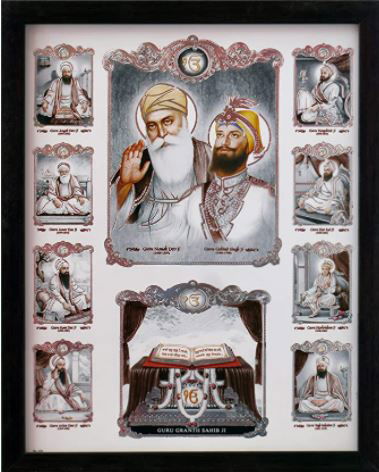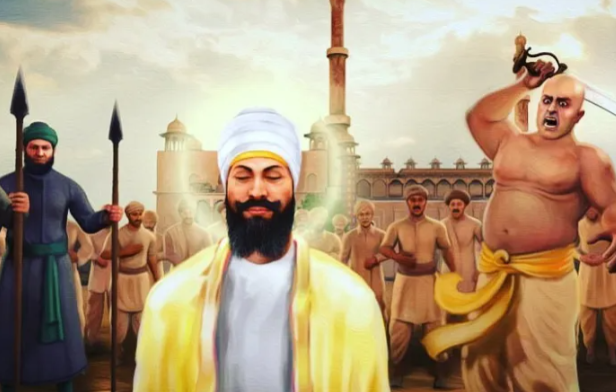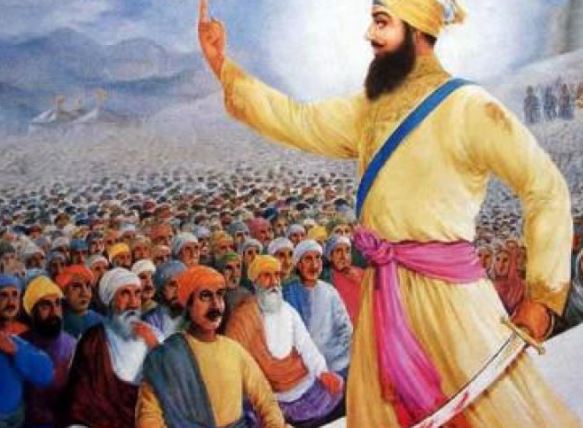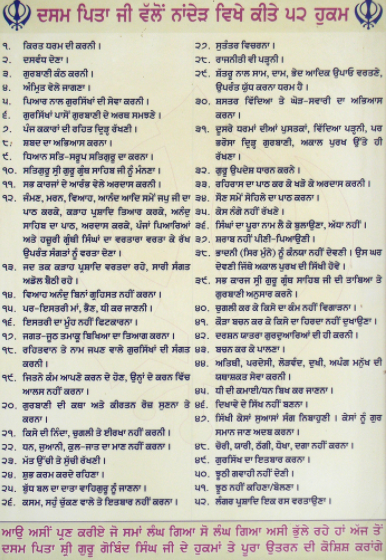Guru Gobind Singh Ji: “Guru who finalized and enshrined the Guru Granth Sahib”


चिड़ियों से मैं बाज लडाऊ , गीदड़ों को मैं शेर बनाऊ !
सवा लाख से एक लडाऊ तभी गोबिंद सिंह नाम कहउँ !!
Chidiya Naal mai Baaz ladawo, Giddran toh mai sher banawo|
Sawa lakh se ek ladawo, Tab Gobind Singh Naam Kehwaoo !!
It is when I make sparrows fight hawks, it is when make I lions out of wolves|
It is when I make one fight a hundred thousand that I am called Gobind Singh Ji ||
Guru Gobind Singh (Punjabi: ਗੁਰੂ ਗੋਬਿੰਦ ਸਿੰਘ) (22 December 1666 – 7 October 1708) was the Tenth Guru of the Sikhs. Guru Gobind Singh born Gobind Rai, was a spiritual master, warrior, poet, and philosopher. When his father, Guru Tegh Bahadur, was executed by cruel Mughal emperor Aurangzeb, Gobind Rai was formally installed as the leader at the age of nine, becoming the tenth and the final human Sikh Guru.
His four sons died during his lifetime – two in battle, two executed by the barbaric Muslim army.
He is fondly remembered by Sikhs as a defender of the faith and a champion of equality and justice. He is also known as the last human Sikh Guru who wrote the “Dasam Granth”, and declared that henceforth the “Guru Granth Sahib” (Sikh Holy Book) would become the next permanent Sikh Guru.
Guru Gobind Singh established “Khalsa“, Society of Soldier-Saints which is considered to be one of the most important events in the history of Sikhism.

Bichitra Natak, Guru Gobind Singh’s autobiography provides life detail of the tenth guru. The Bichitra Natak, Resplendent Drama is a part of the Dasam Granth, The Dasam Granthand a literary collection attributed to Guru Gobind Singh.
Guru Gobind Singh was born as Gobind Rai in Patna, Bihar, to the ninth Sikh Guru Teg Bahadur and his wife Mata Gujri on 22 December 1666, Bihar in the Sodhi Khatri family. While his father was visiting Bengal and Assam. Gobind Rai spent the first five years of his life in Patna. Shrine named Takht Sri Patna Harmandir Sahib marks the site of the house where he was born and spent the first few years of his life.
Guru Gobind’s father, Guru Tegh Bahadur, had founded the city of Anandpur in the year 1665, on the land purchased from the ruler of Bilaspur (Kahlur); land that would later be in dispute. After Tegh Bahadur Ji’s tour of eastern parts of India ended, he asked his family to come to Anandpur. In 1670, his family returned to Punjab, and in March 1672 they moved to Chakk Nanaki in the Himalayan foothills of north India, called the Shivalik Range, where he was schooled.
Gobind Rai’s early education included the study of Punjabi, Braj, Sanskrit, Persian and Arabic languages, and training as a soldier. He had started studying Hindi and Sanskrit while at Patna. In Anandpur, he started studying Punjabi under Sahib Chand, and Persian under Qazi Pir Mohammad. A Rajput warrior was employed to train him in military skills and horse riding.

In 1675 Guru Tegh Bahadur was petitioned by Kashmiri Pandits led by Pandit Kirpa Ram of Matton for protection from the fanatic persecution by Iftikar Khan, the Mughal governor of Kashmir under Mughal Emperor Aurangzeb. Tegh Bahadur considered a peaceful resolution by meeting Aurangzeb, to discuss the emperor Aurangzeb’s policy towards the non-Muslims. Although Guru Tegh Bahadur was cautioned by his advisors that his life may be at risk, he still proceeded to the Mughal capital Delhi.
The young Gobind Rai – to be known as Gobind Singh after 1699 – advised his father that no one was more worthy to lead and make a sacrifice than him.
Guru Tegh Bahadur Ji made the attempt but he was arrested. On 11 November 1675, he was publicly beheaded in Delhi under the orders of Aurangzeb for refusing to convert to Islam and the ongoing conflicts between Sanatana Dharma and the Islamic Empire. His head was put on the public square to deter the public from objecting to Aurangzeb's policies. The beheading of Guru Teg Bahadur frightened many of his disciples, some of whom even refused to acknowledge themselves as his followers, in order to avoid persecution. A disciple called Bhai Jaita (later Bhai Jivan Singh) brought Guru Tegh Bahadur's head to Anandpur.
Before beheading, Guru Tegh Bahadur wrote a letter called Mahalla Dasven to his son, Gobind Rai, also a part of the Guru Granth Sahib, as one last test to find the next Guru, after his father’s martyrdom. After receiving the letter, Gobind Rai was made the tenth Guru on Vaisakhi on 29 March 1676 at the age of 9.
The education of Guru Gobind Singh continued even after he became the 10th Guru, both in reading and writing as well as martial arts such as horse riding and archery. In 1684, he wrote the Chandi di Var in the Punjabi language, a legendary war between the good and the evil, where the good stands up against injustice and tyranny, as described in the ancient Sanskrit text “Markandeya Purana”.

After hearing of what had happened in Delhi, Guru Gobind Ji decided to inculcate the martial spirit among his followers.
Guru Gobind Singh engaged 52 poets to translate the heroic Sanskrit epics into contemporary languages. He selected the warlike theme in many of his compositions to infuse martial spirit among his followers. He also wrote several compositions preaching love, equality and deprecating superstition.
Guru Gobind Singh Ji stayed at a couple of places during his lifespan.
Guru Gobind Rai continued to stay in Anandpur after the persecution of his father. His increasing influence and power worried Raja Bhim Chand of Bilaspur (Kahlur), in whose territory Anandpur was located. Meanwhile, the Guru ordered the construction of a war drum (nagara) called Ranjit Nagara to enthuse his soldiers. The use of such a war drum was limited to the chieftains, within their territory, and the Raja considered the use of Ranjit Nagara a hostile act.
In April 1685, Guru Gobind Rai shifted his residence to Paonta in Sirmur state at the invitation of Raja Mat Prakash of Sirmur. The author of Bichitra Natak does not mention any reason for shifting his residence to Paonta. According to the Gazetteer of the Sirmur state, the Gobind Rai was compelled to leave Anandpur due to differences with King Bhim Chand and went to Toka. From Toka, he was brought to Nahan, the capital of Sirmur by Mat Prakash. From Nahan, he proceeded to Paonta.
He stayed in Paonta, near the banks of river Yamuna, till the end of 1685.
Guru Gobind Rai was married 3 times in his lifetime.

In 1699, the Guru Guru sent hukam nama, letters of authority, to his followers and requested them to congregate at Anandpur on Vaisakhi, the annual spring harvest festival.
He addressed the congregation from the entryway of a small tent pitched on a small hill, now called Kesgarh Sahib. He first asked everyone who He was for them? Everyone answered – “You are our Guru.” He then asked as to whom were they, to which everyone replied – “We are your disciples.” Having reminded them of this relationship, He then said that today the Guru needs something from His disciples. Everyone said, “Hukum Karo, Sache Patshah“, Just give us the order, O Lord. Then drawing His sword, He asked for a volunteer who was willing to sacrifice his head. No one answered his first call, nor the second call, but on the third invitation, a Hindu disciple called Daya Ram, later known as Bhai Daya Singh came forward and offered his head to the Guru. Guru Gobind Rai took the volunteer inside the tent, and emerged shortly, with blood dripping from his sword. According to the tradition, he asked for a volunteer. One came forward, whom he took inside a tent. The Guru returned to the crowd alone, with a bloody sword. He asked for another volunteer and repeated the same process of returning from the tent without anyone and with a bloodied sword four more times. After the fifth volunteer went with him into the tent, the Guru returned with all five volunteers, all safe. He called them the Panj Pyare and the first Khalsa.
Guru Gobind Singh then mixed water and sugar into an iron bowl, stirring it with a double-edged sword to prepare what he called Amrit “Nectar“. He then administered this to the Panj Pyare, accompanied with recitations from the Adi Granth, thus founding the khande ka pahul (ceremony) of a Khalsa – a warrior community. The Guru also gave them a new surname “Singh” from Sanskrit सिंह which means lion.
After the ceremony of the first five Khalsa, the Guru asked to have a ceremony for him so he can himself become Khalsa. This made the Guru the sixth Khalsa, and his name changed from Guru Gobind Rai to Guru Gobind Singh. After he become Khalsa, he announced, “My Khalsa shall always defend the poor, and Deg (community kitchen) will be as much an essential part of your order as Teg (the sword). And, from now onwards Sikh males will call themselves ‘Singh‘ and women ‘Kaur‘ and greet each other with “Waheguru Ji ka Khalsa, Waheguru Ji ki Fateh” which means “The Khalsa belongs to the God; victory belongs to Him”.
Guru Gobind Singh Ji initiated the Five K’s tradition of the Khalsa.
He also announced a code of discipline for Khalsa warriors. Below are forbidden.
The Khalsa also agreed to never interact with those who followed rivals or their successors. The co-initiation of men and women from different Sanatani Varnas into the ranks of Khalsa also institutionalized the principle of equality regardless of one's Varnas or gender.

There are many works that have been attributed to Guru Gobind Singh. Many of his literary works of him were lost during the evacuation of Anandpur Sahib. The collection of writings attributed to Guru Gobind Singh is known as Dasven Padshah Da Granth meaning Book of the Tenth Emperor. It is popularly referred to as the Dasam Granth.
The standard edition of the text contains 1,428 pages with 17,293 verses in 18 sections.The Dasam Granth includes hymns, tales from Hindu Scriptures , a celebration of the feminine in the form of Hindu Goddess Maa Durga, an Autobiography, stories from the Hindu Holy Scriptures of Puranas and the Mahabharata, letters to others such as the Mughal Emperor, as well as reverential discussion of warriors and theology.
The Dasam Granth has a significant role in the initiation and the daily life of devout Khalsa Sikhs. Parts of its compositions such as the Jaap Sahib, Tav-Prasad Savaiye, and Benti Chaupai are the daily prayers (Nitnem) and sacred liturgical verses used in the initiation of Khalsa Sikhs.
Several names of Hindu Gods such as Sham and Ram occur within the compositions composed by Guruji.
The underlying message of all the works is ‘worship the creator and not the creations’. The following works are included in it:
Some scholars have questioned the authorship of some of the parts of the Dasam Granth. The authorship debate on the works started in the twentieth century with the Bashaur School of thought followed by some Sikh scholars from the Institute of Sikh Studies. However, the Akal Takht authorities argue that all the works in the Dasam Granth collection are written by Guru Gobind Singh himself.
Here are a few of his teaching pinched from the 52 Hukams as stated by Guru Gobind Singh–that can be incorporated into our daily lives:
It’s time that we should not just read Guru Gobind Singh Ji Hukams but follow them meticulously in our lives to have peace, love, and harmony within us and in society.
DISCLAIMER: The author is solely responsible for the views expressed in this article. The author carries the responsibility for citing and/or licensing of images utilized within the text.
